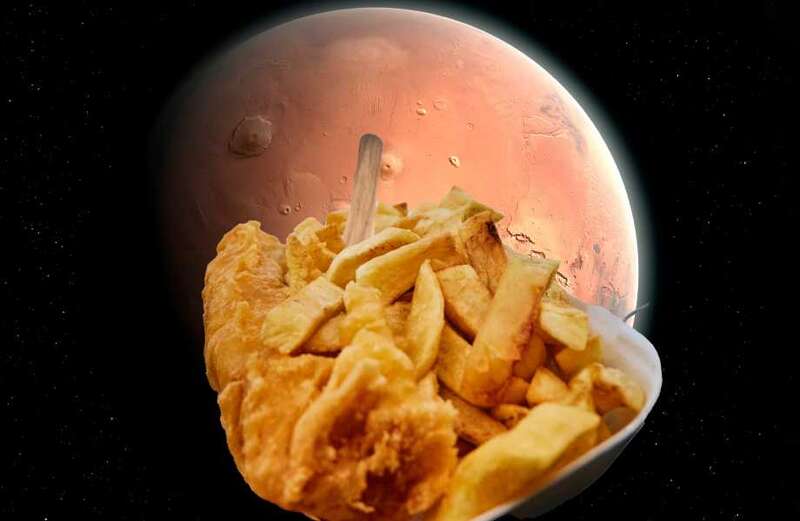COLONISTS living on Mars could grow their own food - including for a fish and chips meal - new tests show.
But there’s one huge hurdle - the red planet’s oxygen-deficient air could kill an unprotected person in less than three minutes.


To colonise Mars, settlers will have to grow their own food, said landscape architecture expert Benz Kotzen, of University of Greenwich in London, the UK.
The race is on to create Mars-friendly food as Nasa wants to set up colonies on the fourth planet from the Sun in the next few decades.
"These missions will only be viable if astronauts can produce their own food," wrote Kotzen on research website The Conversation.
 From tongue scraping to saying no, here are 12 health trends to try in 2023
From tongue scraping to saying no, here are 12 health trends to try in 2023
"Martians will need to grow fresh produce to be healthy and well."
We successfully grew potatoes, tomatoes, dwarf beans, carrots, lettuce, spring onions, chives and basil.
Benz Kotzen, landscape architecture expert
One major problem is that Mars - located 140 million miles from Earth - is a dusty, cold, desert world with a very thin atmosphere.
Its atmosphere is toxic at 95% CO2 - compared to 0.04% carbon dioxide on Earth.
That means that the air on Mars would kill a human quickly.
In fact the average human would die in less than three minutes if left unprotected on the surface, according to Nasa's calculations.
BOILING BLOOD
"If you are unprotected on Mars... your blood would boil, even at ambient temperature," said planetary scientist Pascal Lee, of Nasa's Ames Research Center and the SETI (Search for Extraterrestrial Intelligence) Institute, both in California.
However, Mars has different seasons, polar ice caps, extinct volcanoes, canyons and weather.
"It’s likely there is water in ice form on the surface of Mars and in the rocks below," said Kotzen.
"We set up an aquaponic system to test how to supply Martians with food in the future."
 I'm a nutritionist - here's the 10 best diet trends to help lose weight in 2023
I'm a nutritionist - here's the 10 best diet trends to help lose weight in 2023
FISH AND CHIPS
This food production system sees fish being raised in tanks of water where plants are also grown, so that the nutrient-rich waste from the fish provides food for the plants and the plants keep the water clean.
Waste from the fish is converted by bacteria that occur naturally in water into nutrients for the plants.
The water is returned to the fish after being cleaned by the plants.
Fortunately, the vegetables don't taste of fish, said Kotzen.
The uni team explored how to produce fish and vegetables in a Mars-like environment.
The scientists also checked whether liquid waste from the aquaponics could simulate Martian regoliths - weathered rock, grit and sands that sit above the bedrock.
"Martian regoliths are made only of minerals... and thus lacking the nutrients plants need," he said.
And there was a positive result, as the study found nutrients from the fish water can help grow plants in the hydroponic parts of the aquaponic system.
It could also "potentially work in the Martian regoliths, when treated with effluents taken from the aquaponic systems," Kotzen said.
"We successfully grew potatoes, tomatoes, dwarf beans, carrots, lettuce, spring onions, chives and basil in plant pots containing simulated Martian regoliths, where nutrients were added with the fish water."
The team used tilapia - a mild-flavored species of white freshwater fish found in Africa and the Middle East.
"They are easy to care for and grow relatively quickly, reaching maturity in five to seven months," added Kotzen.
Researchers at Greenwich are also researching alternative fish food, including protein from black soldier fly larvae, which potentially could be produced on Mars.
The expert said the fish "thrived" in the tests.
The system could be replicated in indoor climate-controlled growing tanks on Mars, he added.
"Aquaponics is one of the most sustainable methods of food production as it saves so much water," Kotzen said.
ETHICAL CONCERNS
But, he pointed out that the test results were not a perfect comparison to Earth's abundance and variety of life-forms.
There are ethical considerations, too - so Mars doesn't also end up with pollution problems, as seen on our planet.
"This project offers a solution for food production away from Earth," he added.
"Putting mankind on Mars is a way to ensure the survival of humans in case of disaster on Earth.
"But, we need to first and foremost protect our landscapes, habitats and biodiversity, and ensure every person on this planet is cared for.
"Additionally, we need to ensure that we better protect space and the other planets from our trash.
"We also need to have answers to some hard ethical questions about whether it is right to take other life-forms beyond Earth, where they have evolved over millions of years."
Nasa has said that Mars seems to be a promising nearby place to search for life beyond Earth.
The Perseverance rover has scoured an ancient Martian crater, while the Mars Curiosity rover captured evidence of abundant water, organic molecules and habitable environments in the planet's distant past.
"Technology development has already begun to enable a crewed Mars mission as early as the 2030s," the agency said in 2020.
In February 2024, Nasa called for volunteers to spend a year living in a simulated version of the red planet.
The four-person volunteer crew will live and work inside a 1,700-sq-foot, 3D-printed habitat based at Nasa’s Johnson Space Center in Houston.
